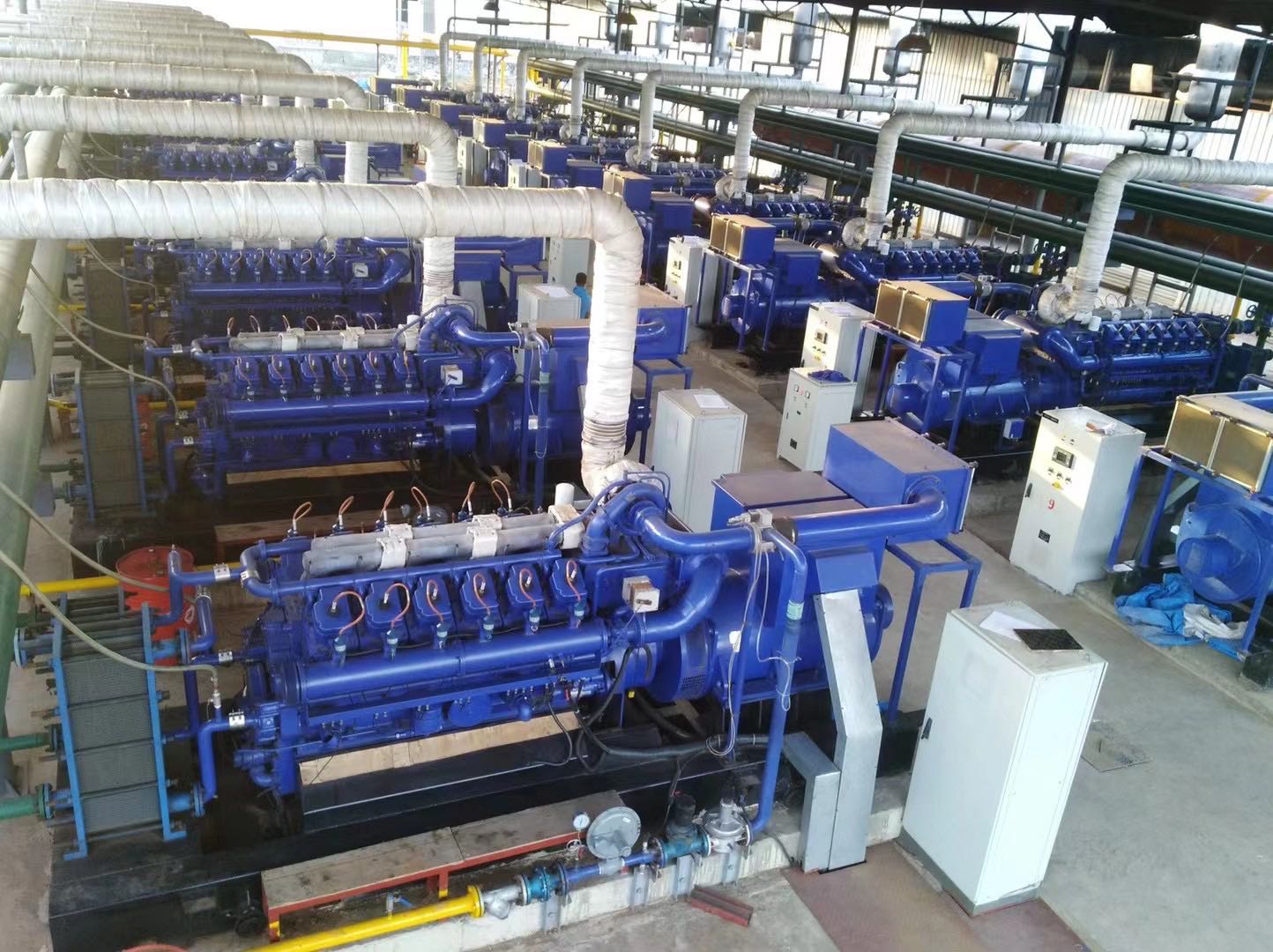 联系 - 热线
联系 - 热线
0531-69953988

 联系 - 热线
联系 - 热线
工业尾气发电机组应用领域全解析
工业尾气发电机组作为一种将工业生产中产生的废气转化为电能的设备,既实现了能源的回收利用,又减少了污染物排放,在环保与节能双重需求下,其应用领域不断拓展,成为工业绿色发展的重要支撑。
As a device that converts waste gas generated in industrial production into electrical energy, industrial exhaust gas generators not only achieve energy recovery and utilization, but also reduce pollutant emissions. Under the dual demands of environmental protection and energy conservation, their application fields continue to expand, becoming an important support for industrial green development.
在化工行业,工业尾气发电机组的应用尤为广泛。化工生产过程中会产生大量富含可燃成分的尾气,如合成氨生产中的弛放气(含有氢气、甲烷等)、甲醇装置的解析气等,这些尾气若直接排放,不仅浪费能源,还会污染环境。工业尾气发电机组可将这些可燃尾气作为燃料,驱动内燃机或燃气轮机运转,带动发电机发电,所发电量可直接用于化工企业的生产用电,降低对外部电网的依赖。例如,在煤化工企业中,通过回收焦炉煤气(主要成分为氢气、甲烷)发电,每小时可产生数千千瓦时电能,满足厂区约 30% 的用电需求,同时减少焦炉煤气燃烧排放的二氧化碳量,实现节能与减排的双重效益。
In the chemical industry, the application of industrial exhaust gas generators is particularly widespread. During the chemical production process, a large amount of exhaust gas rich in combustible components is generated, such as the release gas from synthetic ammonia production (containing hydrogen, methane, etc.) and the desorption gas from methanol plants. If these exhaust gases are directly discharged, they not only waste energy but also pollute the environment. Industrial exhaust gas generators can use these combustible exhaust gases as fuel to drive internal combustion engines or gas turbines, generating electricity directly for the production of chemical enterprises, reducing dependence on external power grids. For example, in coal chemical enterprises, by recycling coke oven gas (mainly composed of hydrogen and methane) for power generation, thousands of kilowatt hours of electricity can be generated per hour, meeting about 30% of the electricity demand in the plant area, while reducing the amount of carbon dioxide emitted from coke oven gas combustion, achieving dual benefits of energy conservation and emission reduction.
冶金行业是工业尾气发电机组的另一重要应用场景。钢铁厂在高炉炼铁、转炉炼钢过程中会产生高炉煤气和转炉煤气,其中高炉煤气含有一氧化碳(约 20%-30%),具有一定的热值。过去,部分钢铁企业将高炉煤气直接点燃放空,既浪费能源又污染大气。引入工业尾气发电机组后,可将高炉煤气净化处理(去除粉尘、水分)后送入发电机组,产生的电力用于驱动高炉风机、水泵等大型设备,多余电力还可并入电网。在炼钢厂,转炉煤气的回收发电已成为成熟技术,一套中等规模的转炉煤气发电机组,年发电量可达数千万千瓦时,相当于节省标准煤数万吨,显著降低企业的能源成本。
The metallurgical industry is another important application scenario for industrial exhaust gas generators. Steel plants produce blast furnace gas and converter gas during the processes of blast furnace ironmaking and converter steelmaking, among which blast furnace gas contains carbon monoxide (about 20% -30%) and has a certain calorific value. In the past, some steel companies directly ignited and vented blast furnace gas, which not only wasted energy but also polluted the atmosphere. After introducing industrial exhaust gas generator sets, the blast furnace gas can be purified (to remove dust and moisture) and sent to the generator sets. The generated electricity is used to drive large equipment such as blast furnace fans and water pumps, and excess electricity can also be integrated into the power grid. In steel mills, the recovery of converter gas for power generation has become a mature technology. A medium-sized converter gas generator set can generate tens of millions of kilowatt hours of electricity annually, which is equivalent to saving tens of thousands of tons of standard coal and significantly reducing the energy costs of enterprises.

建材行业中的水泥、玻璃生产企业,也越来越多地采用工业尾气发电机组。水泥窑在煅烧过程中会产生窑尾废气,其中含有未充分燃烧的煤粉和可燃气体,同时废气温度较高(通常在 200-400℃)。工业尾气发电机组可通过两种方式利用这些废气:一是直接燃烧尾气中的可燃成分发电,二是利用废气的余热驱动汽轮机发电(即余热发电机组)。例如,大型水泥企业的窑尾废气发电机组,年发电量可满足企业自身用电的 40% 以上,不仅降低了生产能耗,还减少了因废气排放带来的热污染。玻璃厂的熔窑尾气同样具有回收价值,其高温特性适合与余热锅炉配合,通过朗肯循环实现发电,兼顾能源回收与环保要求。
Cement and glass production enterprises in the building materials industry are increasingly using industrial exhaust gas generators. During the calcination process of cement kilns, exhaust gas is generated at the kiln tail, which contains unburned coal powder and combustible gases, and the exhaust gas temperature is relatively high (usually between 200-400 ℃). The industrial exhaust gas generator set can utilize these exhaust gases in two ways: one is to directly burn the combustible components in the exhaust gas to generate electricity, and the other is to use the waste heat of the exhaust gas to drive the steam turbine to generate electricity (i.e. waste heat generator set). For example, the kiln tail gas generator set of a large cement enterprise can generate more than 40% of its own electricity annually, which not only reduces production energy consumption but also reduces thermal pollution caused by exhaust emissions. The tail gas from the melting furnace of a glass factory also has recycling value, and its high temperature characteristics are suitable for use with waste heat boilers to achieve power generation through Rankine cycle, balancing energy recovery and environmental protection requirements.
在石油石化行业,工业尾气发电机组多用于处理炼油过程中产生的火炬气。炼油厂在生产过程中,由于工艺调整、设备检修等原因,会排放含有丙烷、丁烷等轻质烃类的火炬气,过去常通过火炬燃烧处理,造成能源浪费。工业尾气发电机组可将火炬气收集、压缩后作为燃料,驱动燃气发电机组发电,所发电量用于炼油厂的生产和生活用电。例如,在大型炼油基地,一套火炬气发电机组每年可回收利用数百万立方米的火炬气,减少二氧化碳排放数万吨,同时为企业创造可观的经济效益,实现 “变废为宝”。
In the petroleum and petrochemical industry, industrial exhaust gas generators are often used to treat flare gas generated during the refining process. During the production process of refineries, due to process adjustments, equipment maintenance, and other reasons, flare gas containing light hydrocarbons such as propane and butane is discharged. In the past, it was often treated through flare combustion, resulting in energy waste. The industrial exhaust gas generator set can collect and compress torch gas as fuel to drive the gas generator set to generate electricity, and the generated electricity is used for the production and domestic electricity of the refinery. For example, in a large oil refining base, a torch gas generator set can recycle millions of cubic meters of torch gas annually, reducing tens of thousands of tons of carbon dioxide emissions while creating considerable economic benefits for the enterprise, achieving the goal of "turning waste into treasure".
垃圾处理与生物质能源领域也能看到工业尾气发电机组的身影。垃圾焚烧发电厂在焚烧垃圾时,会产生高温烟气和可燃气体,工业尾气发电机组可利用这些烟气的余热发电,或直接燃烧垃圾填埋场产生的填埋气(主要成分为甲烷)发电。在生物质发电站,秸秆、木屑等生物质燃料燃烧产生的尾气,经净化处理后可驱动发电机组,进一步提高生物质能源的利用效率。例如,垃圾填埋场的填埋气发电机组,既能减少甲烷(温室气体)排放,又能为周边居民提供电力,实现环境治理与能源供应的协同发展。
Industrial exhaust gas generators can also be seen in the fields of waste disposal and biomass energy. Garbage incineration power plants generate high-temperature flue gas and combustible gases during the incineration of garbage. Industrial exhaust gas generators can use the waste heat from these flue gases to generate electricity, or directly burn the landfill gas (mainly composed of methane) produced by the garbage landfill to generate electricity. In biomass power plants, the exhaust gas generated from the combustion of biomass fuels such as straw and sawdust can be purified and used to drive the generator set, further improving the utilization efficiency of biomass energy. For example, landfill gas generators in landfills can reduce methane (greenhouse gas) emissions and provide electricity to surrounding residents, achieving coordinated development of environmental governance and energy supply.
本文由工业尾气发电机组友情奉献.更多有关的知识请点击:http://www.zhongtuopower.cn我们将会对您提出的疑问进行详细的解答,欢迎您登录网站留言.
This article is a friendly contribution from the analysis of gas generator sets For more information, please click: http://www.zhongtuopower.cn We will provide detailed answers to your questions. You are welcome to log in to our website and leave a message
业务分类
Business classification产品推荐
product recommendation联系方式
Contact Information

截屏,微信识别二维码